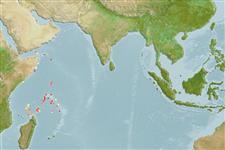Environment: milieu / climate zone / depth range / distribution range
Ecologie
marien benthopelagisch; diepte 810 - 1022 m (Ref. 26165). Deep-water; 16°N - 12°S, 44°E - 60°E (Ref. 6181)
Western Indian Ocean: in tropical areas. Western Central Pacific: Southeast Asia. References to a catch from Walvis Ridge in the southeastern Atlantic are based on a single specimen from the collection of Pakhorukov that requires confirmation.
Grootte / Gewicht / Leeftijd
Maturity: Lm ? range ? - ? cm
Max length : 100.0 cm SL mannelijk / geslacht onbekend; (Ref. 27121)
Dorsale stekels (totaal): 41 - 43; Dorsale zachte stralen (totaal): 53-55; Anale stekels 2; Anale zachte stralen: 43 - 46; Wervels: 99 - 102. Pelvic fins represented by a single spine in juveniles inserted before the base of the pectoral fins, but entirely absent in adults. Body color is coppery black with iridescent tint. The inside of the mouth and gill cavities black.
Inhabits deeper waters of continental shelf and slope (Ref. 27121).
Levenscyclus en paargedrag
Maturiteit | Voortplanting | Paaien | Eieren | Fecunditeit | Larven
Nakamura, I. and N.V. Parin, 1993. FAO Species Catalogue. Vol. 15. Snake mackerels and cutlassfishes of the world (families Gempylidae and Trichiuridae). An annotated and illustrated catalogue of the snake mackerels, snoeks, escolars, gemfishes, sackfishes, domine, oilfish, cutlassfishes,. scabbardfishes, hairtails, and frostfishes known to date. FAO Fish. Synop. 125(15):136 p. (Ref. 6181)
Status op de Rode Lijst van het IUCN (Ref. 130435)
Gevaar voor de mens
Harmless
Gebruik door de mens
Meer informatie
Lokale namenSynoniemenMetabolismePredatorenEcotoxicologieVoortplantingMaturiteitPaaienPaaiaggregatiesFecunditeitEierenOntwikkeling van de eieren
ReferentiesAquacultuurAquacultuurprofielKweeklijnenGeneticaElectrophoresesErfelijkheidZiektesVerwerkingNutrientsMassaconversie
Tools
Speciale rapporten
Download XML
Internetbronnen
Estimates based on models
Preferred temperature (Ref.
123201): 1.8 - 3.2, mean 2.5 °C (based on 30 cells).
Fylogenetische diversiteitsindex (Ref.
82804): PD
50 = 0.5078 [Uniqueness, from 0.5 = low to 2.0 = high].
Bayesian length-weight: a=0.00046 (0.00020 - 0.00105), b=3.12 (2.92 - 3.32), in cm total length, based on LWR estimates for this (Sub)family-body shape (Ref.
93245).
Trofisch niveau (Ref.
69278): 4.2 ±0.7 se; based on size and trophs of closest relatives
Weerstandsvermogen (Ref.
120179): laag, minimale populatieverdubbelingstijd 4,5-14 jaar (Assuming tmax>10).
Fishing Vulnerability (Ref.
59153): High to very high vulnerability (73 of 100).
